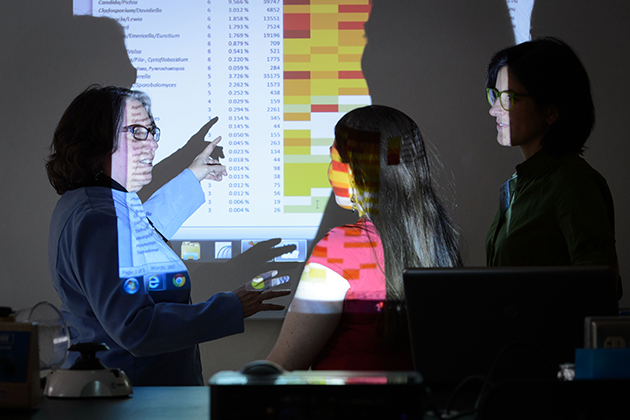Genome Research on Mouth Fungi May Help Predict Infections
Using a novel genome-based approach, researchers in UConn’s College of Liberal Arts and Sciences and School of Dental Medicine have identified and described the community of fungi that lives in an average healthy person’s mouth.
The findings will eventually help medical professionals better understand, treat, and possibly prevent the oral infections that can occur in many patients whose immune systems are suppressed, like people undergoing therapy for cancer and the elderly.
These infections often make it hard for people to eat, take medications, and even speak, and have the potential to spread to other parts of the body.
Linda Strausbaugh, left, professor of molecular and cell biology, Amanda Dupuy, a Ph.D. student, and Patricia Diaz, assistant clinical professor of periodontology, review research data in a lab at Beach Hall. (Peter Morenus/UConn Photo)
“There has been a lot of genome work done on bacteria in the body, but almost none on fungi,” says Linda Strausbaugh, professor of molecular and cell biology in CLAS.
“This is the first study to identify medically-important oral fungi on a large scale,” she notes. “Our study is particularly important because we developed methods to assure the identifications we were making from genomic data were indeed correct. Our long-term goal is to help take a personalized approach to medicine.”
The findings are based on the idea that these infections are associated with the disruption of people’s normally-functioning complement of bacteria and fungi in their mouths.
Like the complement of non-harmful bacteria in the mammalian gut, many species of bacteria and fungi live peacefully in the mouths of humans and other mammals. Characterizations have typically involved studies that take swabs of people’s mouths and then identify fungi by culturing them in the laboratory.
These studies are limited, says Strausbaugh’s graduate student Amanda Dupuy, because they rely on getting fungi to grow in laboratory conditions, which are often unfavorable.
“This genomics approach is so important,” says Dupuy, “because it uses DNA to identify the full range of fungi found in the mouth.”
Strausbaugh, Dupuy, and their colleagues used a novel approach to “breaking” fungi in the laboratory, using special zirconia beads to crack open fungi collected from people’s saliva samples, allowing them to investigate the DNA of a wide range of oral fungi.
“Many of us think of fungi solely as mushrooms,” says Strausbaugh. “But most are not mushrooms, and some are encapsulated in hard cellular walls, which need to be broken so we can get at the DNA inside.”
This approach allowed the research group to identify more than 25 groups of fungi that occurred in more than half of their research subjects, and also to identify a species of fungus that was very prominent but never before observed in the mouth. Dupuy says that these top 25 groups are biomedically important because they represent a baseline description of an average person’s mouth.
“Each person has a unique complement of mouth fungi,” says Strausbaugh. “We know that people are genetically predisposed to things. So, is it possible that we are predisposed to different communities of fungi?
“The interesting thing here is the potential for predictive ability,” Strausbaugh adds. “Can we potentially come up with a set of biomarkers that could predict whether a person is at risk for fungal infections?”
The next step in the group’s research, says Patricia Diaz, professor of dental medicine at the UConn Health Center and the project’s director, is to look at how the oral fungal community changes over time in people undergoing chemotherapy treatments, and track whether changes are related to the development of oral lesions. These results could help scientists and medical professionals better predict patients’ risk of oral infection.
“Some of these normally harmless fungi, given the right circumstances, could cause mischief,” says Strausbaugh. “There is concern about fungi as emerging human pathogens, especially in immunocompromised people, infants, and older adults.”
Dupuy, a fifth-year Ph.D. student, says that the project has given her a perspective on how genomics can interact with people’s daily lives.
“I always had a vision of helping people by using genetics,” she says. “This project has opened my mind to what genetics and genomics can really do.”
This research appears in the March 10 issue of PLOS One. The project is supported by a four-year, $3 million National Institutes of Health grant.
